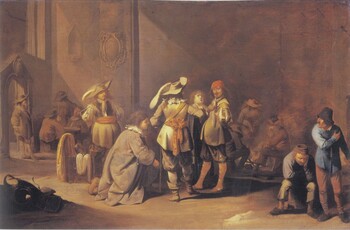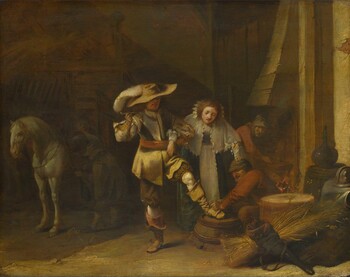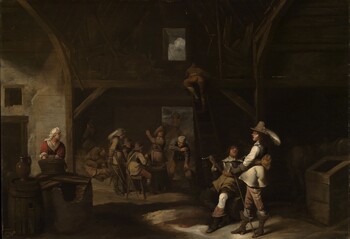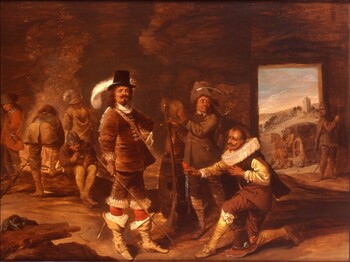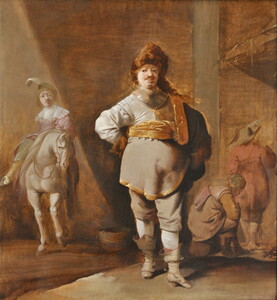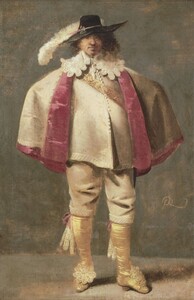11.000 €
A guardroom interior scene
Oil on panel : 38,2 X 45,8 cm
Monogrammed and dated bottom left “PQ / 1639”
Frame : 51,2 X 59,6 cm
Provenance : sold at Sotheby’s Amsterdam, 11/11/97 for 70.800 DG
= 32.056 €
= 32.056 €
Our painting is registered at the RKD The Hague, under the number 6503
In short
Pieter Jansz. Quast often painted satirical scenes. Here he has brilliantly captured in just a few monochrome colours the resignation of a nation too long at war.
One can fully appreciate the genius of Quast, now that our painting has been cleaned from its old, smothering varnish.
About Pieter Jansz. Quast
Dutch painter
Amsterdam circa 1605/06 – 1647 Amsterdam
Genre scene painter, he also painted some landscapes, religious scenes and portraits.
It is not known whom he studied under.
He was the master of Jan Jansz. Buesem (1599/1600 – in or after 1649) around 1630 and of the little-known portrait painter Dirk Cornelisz. de Hooch (1613 – in or after 1651) in the period 1630/35.
His interior scenes were often satirical and caricatural. He painted merry groups of peasants, elegant companies and guardroom scenes. He also loved depicting quack doctors.
Quast was active in his birthplace Amsterdam, except for the period 1634 – 1641 when he worked in The Hague. In 1632 he had married a lady from The Hague.
His sense for witty subjects depicted with a narrative clarity reminds of Adriaen Pietersz. van de Venne (1589 – 1662) who lived from 1625 until his death in The Hague.
About guardroom scenes
Our painting represents the interior of a guardroom.
In French a guardroom is called ‘un corps-de-garde’, which in Dutch evolved towards ‘een kortegaerden’.
Until 1648 the Eighty Years’ War was fought, which one may call the Dutch war of independence from Spain. It ended with the final recognition, by Catholic Spain, of the independent, largely Protestant Republic of the Seven United Provinces. Flanders remained Spanish and Catholic.
After the Twelve Years’ Truce (1609 – 1621) the Eighty Years’ War had evolved towards a slow war of sieges. In between and during these sieges there were long periods of inactivity, which the contemporary painters portrayed with a lot of sense for psychology.
In Dutch painting guardroom scenes really evolved to become a popular subject with several specialists active in this domain: Jacob Duck, Pieter Codde, Willem Duyster, Jan Olis, but above all Anthonie Palamedesz..
Most Dutch guardroom scenes show soldiers either killing time (playing cards or dice, or smoking a pipe, sleeping or drinking), flirting with prostitutes, inspecting their weapons or showing their booty to a superior.
About our painting
Circa 1625 Jan van Goyen in landscape painting and Jan Porcellis in marine painting revolutionized Dutch painting by replacing vivid colours by tonal, monochrome tonalities. Many painters followed their example.
This new fashion lasted until the mid 1640s.
Quast has divided the monochrome scene in two: at left the strongly lit, proud figure of the smoking officer, in the background modest figures around a fire. With a great sense of psychology, Quast has depicted the boredom and lack of fighting spirit of these simple soldiers and a of single wife and her baby.
Why should you buy this painting?
Because Quast has perfectly captured the apathy due to a never ending war: in 1639 the Netherlands had been fighting for its independence of Habsburg Spain for 59 years. Sovereignty and peace would finally be reached in 1648.
Comparative paintings
Click photos for more details

